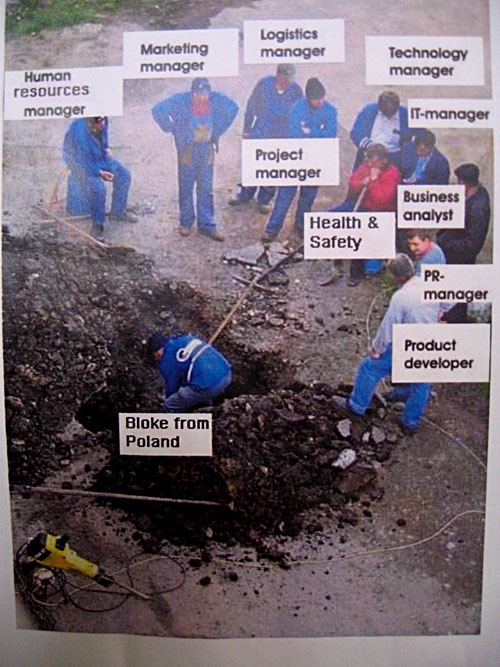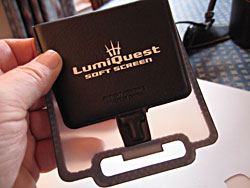
Spotted in a colleague’s office.


Spotted in a colleague’s office.

I hate using flash but sometimes it’s the only way of getting pictures. Like most DSLRs, my Nikon D70 has a pop-up flash and it produces the kind of horrible washed-out images one comes to expect from such lighting. The solution (I naively thought) was obvious: put my trusty Nikon Speedlight atop the D70 and use it in bounce mode. And then I discover that the fiends in Nikon have arranged things so that my analog flashgun won’t work with their digital cameras. Worse: a digital-compatible Speedlight costs an arm and a leg, or at any rate £224.35 inc. VAT.
Enter the LumiQuest Softscreen — a cheap gizmo made in China.

It fits on the top of the camera like this:

and gives quite reasonable results.
It’s not pretty, but what do you expect for less than £10? I got if from Warehouse Express.
Lovely observant note by Dave Winer…
I watched yesterday’s Bush press conference. There’s absolutely no doubt that he’s selling war with Iran. And this morning, I saw CNN help him with the pitch.
According to CNN, our sometime enemy in Iraq, radical Shi’ite cleric Moqtada al-Sadr, may now be in Iran. He may not be there, but it’s possible that he’s there. Right now. That was the news, it was a headline, scoop-level story. We’re not sure he’s there, but he could be. That’s news? Eh.
They also said, but didn’t emphasize, that if he were in Iran this wouldn’t be anything new, he’s often in Iran.
He’s also part of the coalition that forms the government of Iraq, the one that we’re supporting, the one that we’re funding, and arming. But this time, today, they didn’t mention that he’s our friend in Iraq, because today he’s being portrayed as our enemy in Iraq. But given that he’s part of the government of Iraq, him being in Iran is like Ted Kennedy being in Mexico. It’s conceivable that al-Sadr has legitimate business in Iran. But it’s hard for us to conceive of that, supposedly, because the picture that’s being painted is that Iran is the country that’s killing our soldiers. And we’re supposed to conclude, of course, that al-Sadr, being in Iran (if he actually is) is more evidence of that. They don’t say it, but we’re left wondering why this is news. If he isn’t there plotting the deaths of more Americans, exactly why is he in Iran? (Assuming he is.) Clearly he’s up to no good.
In other words, they’re just moving around words to make it sound like something new and dangerous is happening, when in fact nothing new is happening, and if it is dangerous, it is something that in the past, the same people have asked us to overlook the danger in.
One more thing — in the Bush press conference, not only haven’t the reporters asked Bush to explain who the enemy is, they also talk about the enemy themselves, although if pressed, I doubt if any of them could explain exactly who the enemy is. Maybe they should do a Frontline special explaining the complicity of the professional journalists in U.S. propoganda.
Summary: One day al-Sadr is the enemy and another day he is our ally.
What could “winning” in Iraq possibly mean?
Problem: We have no clue who we’re fighting.
Having blogged Martin Weller’s reflections on his 100th post, I came on this — an intelligent, hour-long documentary on the subject by Chuck Olsen. It’s an excellent introduction. Worth recommending to students.
This is a neat idea. Chris Anderson has been flogging his book all over the world and has got so tired of certain criticisms that he’s gathered his retorts into one place: “The Five Top Mistakes of Long Tail Criticism”.
I hope David Irving doesn’t spot this trick.
Lara Pawson has arrived in Angola and is writing…
I’m looking for the mermaids in the car-park, the ones who came out at night, who swam to the shore and drifted over the land to mingle among the muddy bars in the evening. I asked my friend who first taught me how to see as sereias if he knew where they were but he looked at me strangely, puzzled at my question. So the mermaids have gone. I looked and looked and all I saw was a ginger cat’s convulsing stomach, two kittens sucking hard on her, kneading around her teats for milk, desperate to feed their tiny frames. She kept on licking her front legs and their heads, her stomach heaving and bursting with air, and soon they gave up and drank from black pools with filthy pigeons sucking at their side. So much hooting and so many cars. Water drips on blouses from exhausted air-conditioners pulling at the air above. ‘I keep my air conditioner on just to block out the sounds outside,’ a large lady said. Dripping water is a form of torture. Water drips from tanks and air-cons, leaking cars and blue and white plastic. I can hear dripping water and hooting cars and police helicopters and sirens, and distorted seventies soul music blasting from black boxes under a layer of dust, and a police whistle, and a killer computer game, and birds – those budgies…
“When you want a computer system that works, just choose Linux.
When you want a computer system that works, just, choose Microsoft.”
Seen in an email signature.
Martin’s reached his 100th post and is reflecting on it.
This is emphatically not a ‘guide to becoming a blogger’ since I don’t think one person can tell someone else how to do that. Just my thoughts on my experience:
Firstly, I narrowed the focus. Previously I had tried to be a blogger for all people, but I found it necessary to have a specific subject area, in my case educational technology and e-learning. With this acting as a spine I could branch of occasionally in to other subjects (witness ramblings on football), but generally I found it easier to use this as a basis.
Secondly, I found an appropriate tone. I had struggled before with how to comment on, say, meetings I had been in. While ‘X was their usual curmudgeonly self’ may be true it is both libellous and not very interesting to others. So I tend to use the meetings as springboards for more general points.
Thirdly, I built up some momentum before I let people know about it. This was helped by writing a book at the time, so I had lots to say and time to say it.
Lastly, I began to think about everyday experiences in terms of blog postings…
He’s right about tone. One of the things our students find difficult about blogging is the difficulty of finding an authentic ‘voice’. Most people are unaccustomed to publishing their ideas in any kind of forum. So blogging presents a terrifying challenge; it raises awkward questions like: to whom am I addressing these semi-random thoughts? And why am I doing it anyway?

This is a PowerPoint slide from a White House briefing by General Tommy Hanks in August 2002 explaining how post-Saddam Iraq would be managed in a series of orderly stages (‘Stabilization’, ‘Recovery’, ‘Transition’) which would require only 5,000 US troops in country by 2006. The presentation was obtained by George Washington University’s National Security Archive under the Freedom of Information Act. It makes one wonder what these guys were smoking.
The NYT comments:
August 2002 was an important time for developing the strategy. President Bush had yet to go to the United Nations to declare Saddam Hussein’s supposed weapons programs a menace to international security, but the war planning was well under way. The tumultuous upheaval that would follow the toppling of the Hussein government was known antiseptically in planning sessions as “Phase IV.” As is clear from the slides, it was the least defined part of the strategy.
General Franks had told his officers that it was his supposition that the State Department would have the primary responsibility for rebuilding Iraq’s political institutions.
“D.O.S. will promote creation of a broad-based, credible provisional government — prior to D-Day,” noted a slide on “key planning assumptions.” That was military jargon for the notion that the Department of State would assemble a viable Iraqi governing coalition before the invasion even began.

Walking on a beach today, we came on this pattern in the sand made by rivulets heading towards a small pool. My guess is that a satellite image of the Ganges or Nile deltas would show a similar pattern (minus the footprint!)